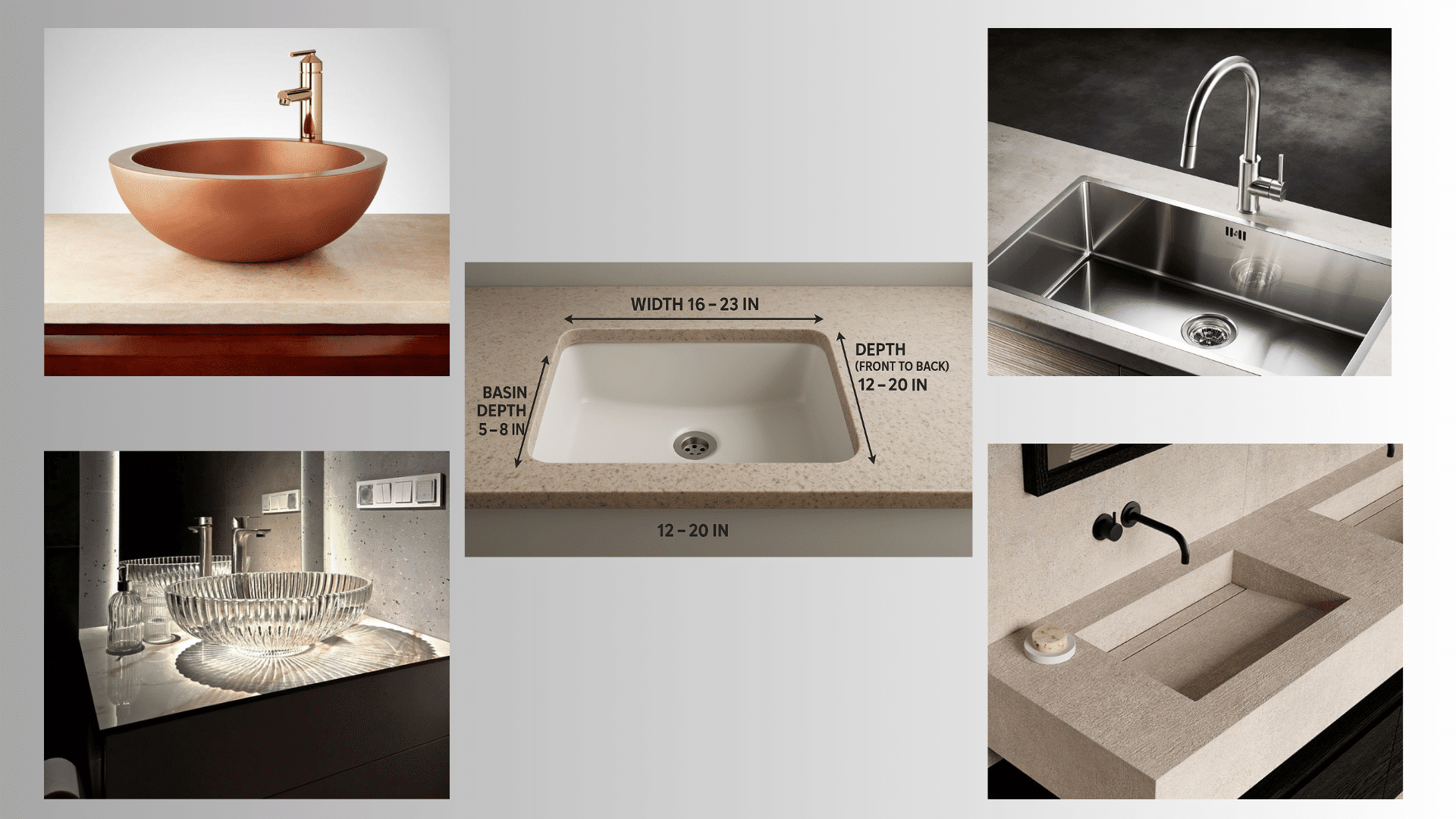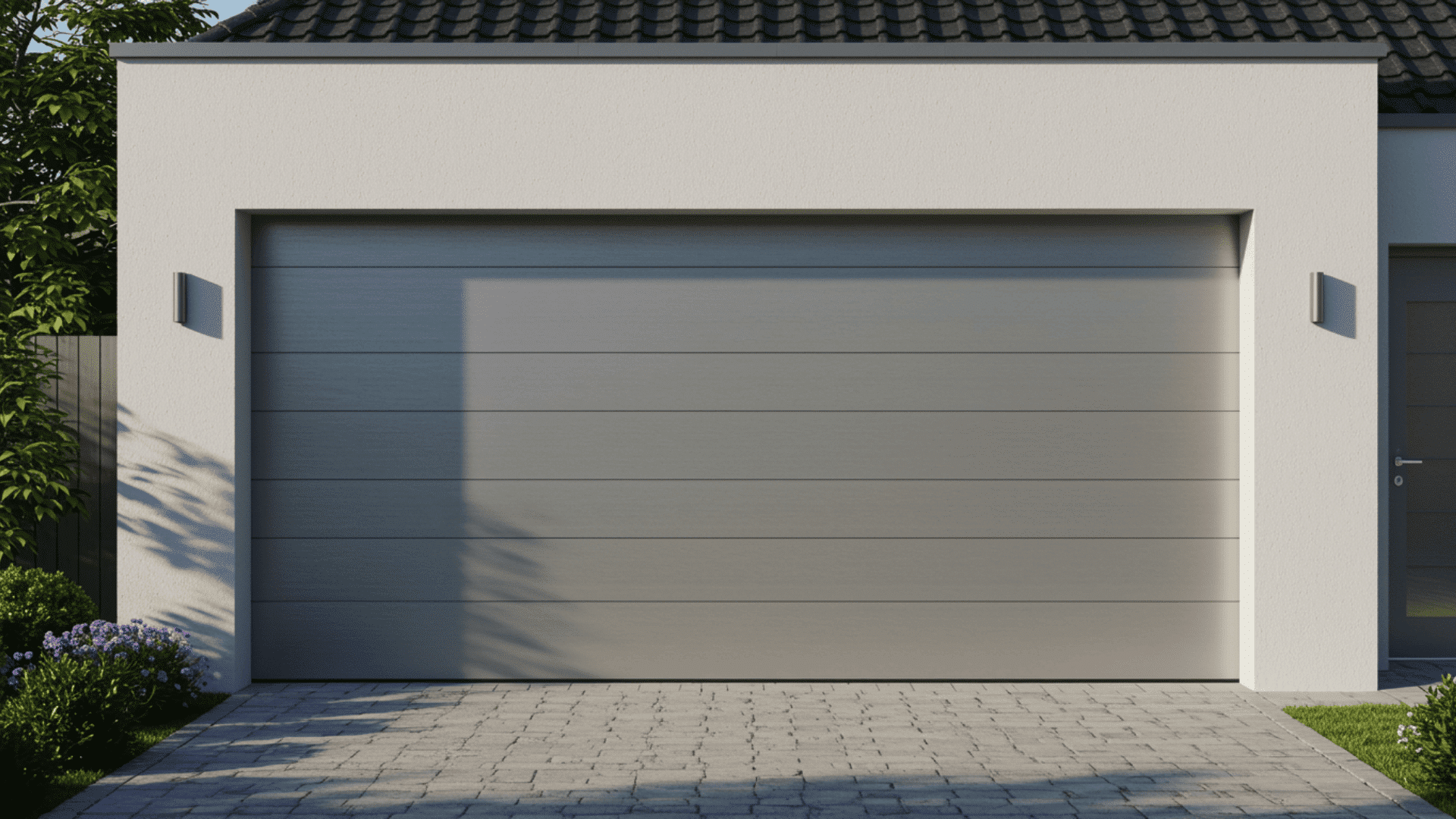Choosing the right sink can be tricky when working with limited bathroom space. People measure once, twice, maybe three times, but those bathroom sink dimensions still feel confusing.
Standard sizes exist, sure, but what actually fits the vanity? And will it look proportional?
Here you will find everything you need to know about sink measurements. It covers standard dimensions for different sink types, how to measure the space correctly, and what size works best for specific bathroom layouts.
How to Measure Bathroom Sink Dimensions?
Accurate bathroom sink measurements ensure a perfect fit for any bathroom renovation. Begin by measuring the available counter space from left to right (width), front to back (breadth), and the distance from the back wall.
Account for faucet holes and plumbing connections beneath the vanity. Most sinks range from 16 to 24 inches wide, 12 to 22 inches deep, with basin depths between 4 and 8 inches.
Always measure twice and leave at least four inches of counter space on each side for comfortable use and proper installation.
For replacement projects, measure the existing sink’s cutout and verify that plumbing lines align with the new fixture.
Professional measurements help avoid costly installation mistakes and ensure the sink complements the bathroom’s layout perfectly.
Bathroom Sink Types and Their Dimensions
Each sink type offers distinct measurements that affect both functionality and fit. Here’s a breakdown of common styles with their average bathroom sink size specifications.
1. Drop-In Sinks

Drop-in sinks feature a visible rim that rests on the countertop, making installation straightforward for DIY projects.
These evergreen fixtures work with any countertop material and remain the most popular choice for bathroom vanities.
- Width: 16–24 inches
- Breadth: 12–20 inches
- Basin Depth: 5–8 inches
- Cost Range: $50–$300
2. Undermount Sinks
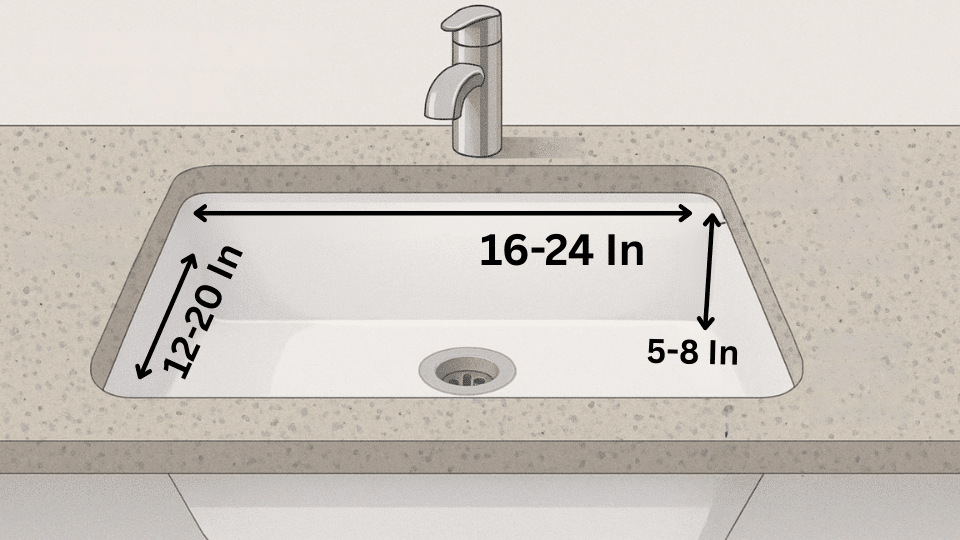
Undermount sinks are installed beneath the countertop for a seamless, modern appearance.
The rimless design makes countertop cleaning effortless and creates a high-end look suitable for contemporary bathrooms with solid surface countertops.
- Width: 16–23 inches
- Breadth: 12–20 inches
- Basin Depth: 5–8 inches
- Cost Range: $150–$500
3. Vessel Sinks

Vessel sinks sit above the counter like decorative bowls, creating a striking focal point. These statement pieces require taller faucets and come in various materials, including glass, stone, ceramic, and copper, for ultimate customization.
- Width: 14–20 inches (diameter for round)
- Breadth: 14–20 inches
- Basin Depth: 5–7 inches
- Cost Range: $80–$600+
4. Pedestal Sinks
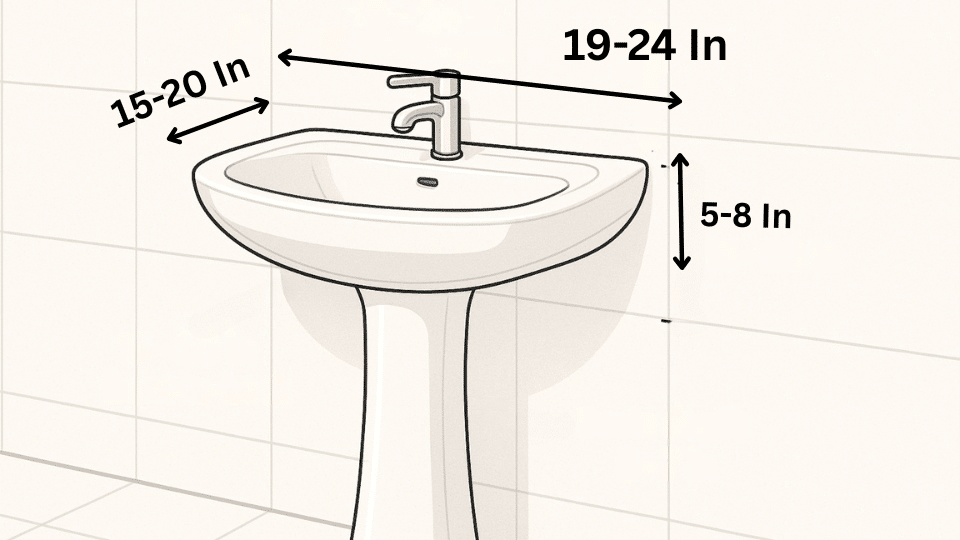
Pedestal sinks combine a basin with a freestanding column that conceals plumbing lines.
This classic design works beautifully in smaller bathrooms or powder rooms where floor space is limited, though storage remains minimal.
- Width: 19–24 inches
- Breadth: 15–20 inches
- Basin Depth: 5–7 inches
- Cost Range: $100–$500
5. Wall-Mounted Sinks
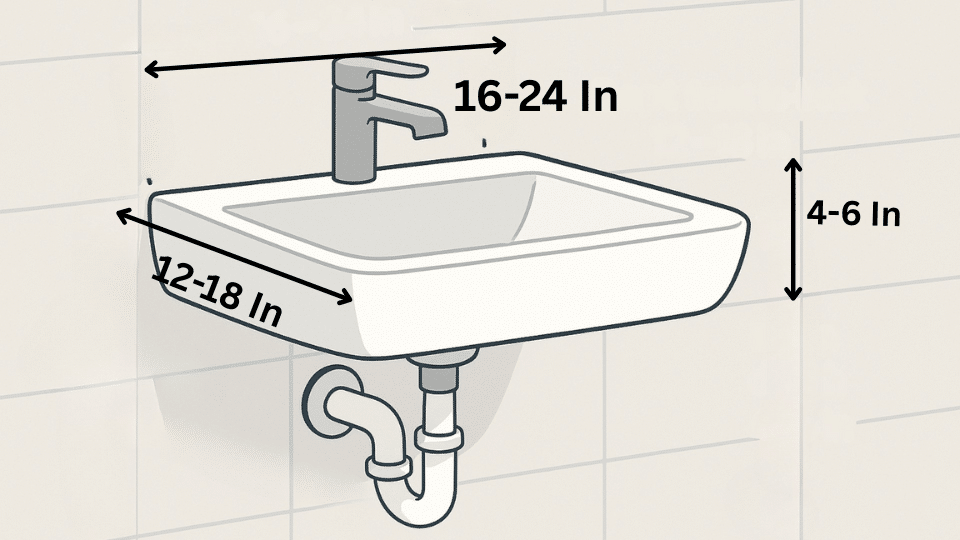
Wall-mounted sinks attach directly to the wall without cabinet support, maximizing floor space in compact bathrooms.
Perfect for minimalist designs and wheelchair-accessible bathrooms, though exposed plumbing may require decorative covers.
- Width: 16–24 inches
- Breadth: 12–18 inches
- Basin Depth: 4–6 inches
- Cost Range: $75–$400
6. Console Sinks
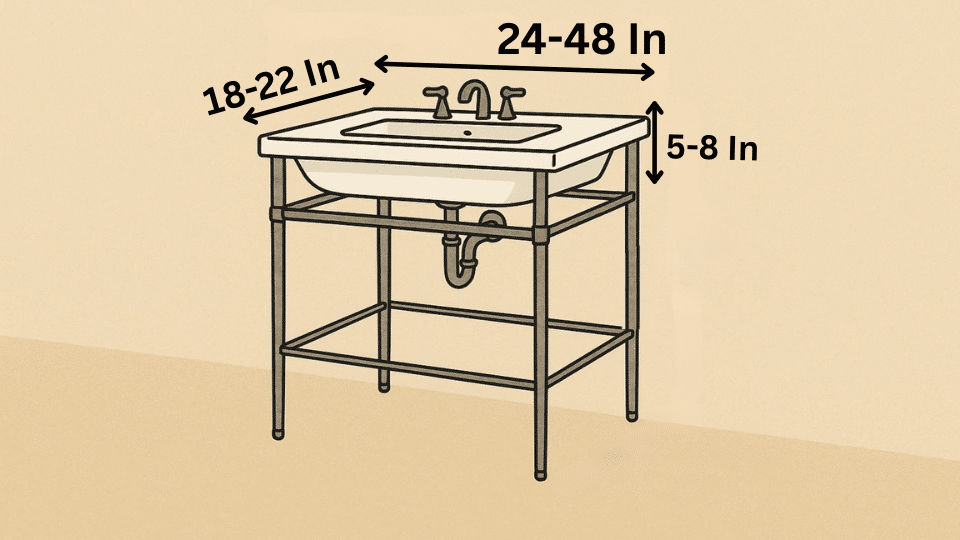
Console sinks blend a basin with a decorative metal or wooden framework, offering pedestal-sink beauty with added functionality.
These vintage-inspired fixtures suit traditional bathroom sink measurements while providing space underneath for towel storage.
- Width: 24–48 inches
- Breadth: 18–22 inches
- Basin Depth: 5–8 inches
- Cost Range: $200–$800
7. Corner Sinks

Corner sinks maximize space efficiency by fitting snugly into unused corners. These specialized fixtures solve layout problems in tight powder rooms where standard bathroom sinks won’t fit, often including small side shelves.
- Width: 12–17 inches (each side)
- Breadth: 12–17 inches (diagonal)
- Basin Depth: 4–6 inches
- Cost Range: $100–$350
8. Double-Bowl Vanity Sinks

Double-bowl vanity sinks provide two separate basins for shared bathrooms.
Each basin typically measures 16–20 inches wide, with adequate spacing between bowls, making these among the largest average bathroom sink sizes available.
- Width: 48–72 inches (total)
- Breadth: 18–22 inches
- Basin Depth: 5–8 inches
- Cost Range: $300–$1,200
Best Materials for Different Sink Sizes and Styles

Choosing the right material increases both the durability and the vibe of your bathroom sink. Different materials complement specific sink types and withstand daily use differently.
1. Porcelain and Ceramic
Porcelain and ceramic remain the most popular choices for drop-in, undermount, and pedestal sinks due to their affordability and appeal.
These materials resist staining, clean easily with standard household products, and maintain their glossy finish for years.
They work beautifully in both traditional and contemporary bathrooms. However, they can chip or crack under heavy impact, so they require careful handling during installation.
2. Stainless Steel
Stainless steel suits modern and industrial-style bathrooms, particularly for undermount installations. This material resists corrosion, bacterial growth, and heat damage while offering exceptional durability.
It’s lightweight, making it easier to install than stone alternatives.
Water spots and fingerprints show more readily on stainless surfaces, requiring regular wiping to maintain their sleek appearance.
3. Natural Stone
Natural stone materials like granite, marble, and onyx create stunning vessel sinks that serve as bathroom centerpieces.
Each piece offers a range of colors and patterns that add organic beauty to the space.
Stone requires periodic sealing to prevent staining and water damage. These heavier materials demand reinforced countertops and professional installation for proper support.
4. Glass
Glass vessel sinks add artistic flair to contemporary bathrooms, available in transparent, frosted, or colored options. They’re surprisingly durable when made from tempered glass and create a sense of visual lightness in small spaces.
Glass showcases water spots and soap residue easily, requiring frequent cleaning to look pristine. These sinks pair beautifully with minimalist vanities and wall-mounted faucets.
5. Copper
Copper sinks offer warmth and character, developing a natural patina over time that improves their rustic charm. They possess antimicrobial properties that naturally inhibit bacterial growth.
Copper works wonderfully for vessel and drop-in styles in farmhouse or eclectic bathrooms.
How to Choose the Right Size Based on Use and Style?
Selecting the perfect bathroom sink dimensions requires balancing practical needs with design preferences. Before committing to a purchase, think through how the sink fits into daily routines and overall bathroom vision.
Measure available vanity or wall space carefully, accounting for surrounding fixtures that affect bathroom sink measurements and placement.
Single users can opt for compact 16-18-inch sinks, while families benefit from larger 20-24-inch basins or double vanities. Leave at least 4 inches of counter space on each side for toiletries and grooming tools.
Consider storage needs, vanity-mounted sinks provide cabinet space, while pedestal or wall-mounted styles maximize floor area.
Align choices with design style: modern bathrooms suit sleek undermount or vessel sinks, while traditional spaces call for classic drop-in or pedestal designs.
Making the Right Choice
Selecting the perfect sink is about making your bathroom work beautifully and functionally. From knowing standard sizes to taking accurate measurements, these details matter more than most realize.
The right bathroom sink dimensions change cramped spaces into efficient retreats.
Whether working with a tiny powder room or a spacious master bath, proper measurements help maximize every available inch. Smart choices today create the dream bathroom tomorrow.

